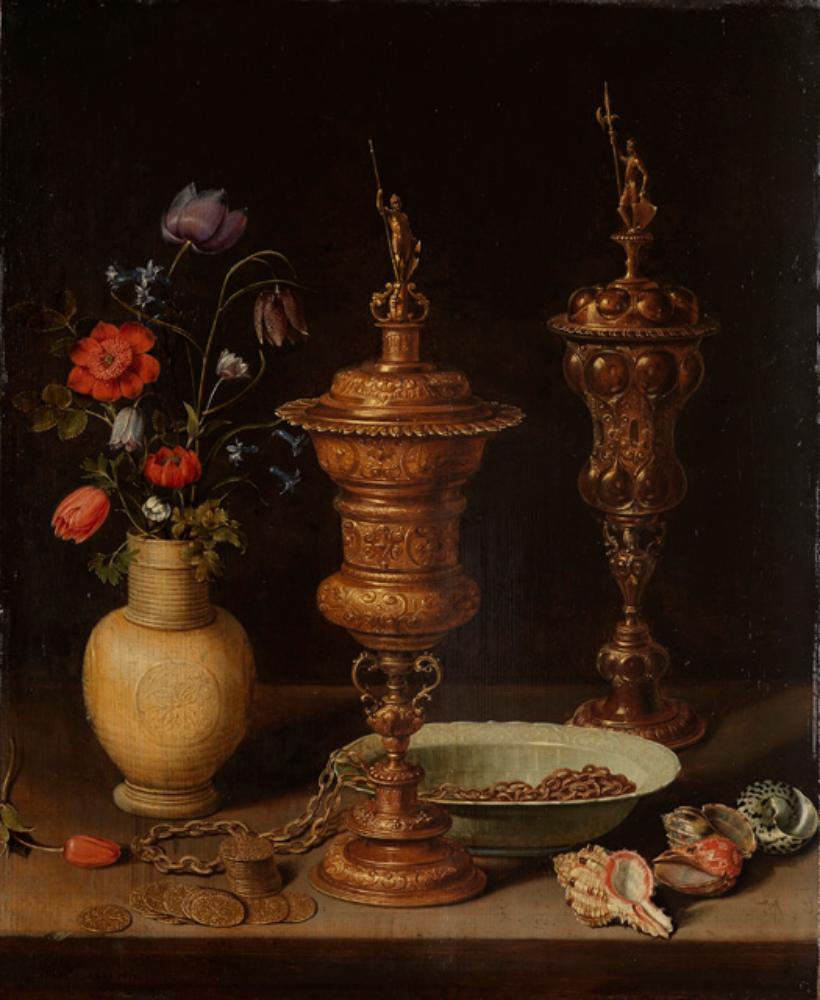
| X (Twitter) | |
|---|---|
URL kopieren
Die URL wurde erfolgreich kopiert und befindet sich in der Zwischenablage |
|
Im Zuge des Website-Relaunchs finden Sie hier vorerst keine hochauflösenden Abbildungen. Im Hintergrund arbeiten wir daran, sie Ihnen an dieser Stelle schnellstmöglich präsentieren zu können. Bis dahin wenden Sie sich gerne per Mail an digital@kunsthalle-karlsruhe.de, wenn Sie Abbildungen in hoher Auflösung benötigen.
Still Life with Flowers and Gold Cups of Honour
Clara Peeters
H 49cm W 59.5cm
1612
KunsthalleKarlsruhe@ZKM
Description
All the objects gathered together in this still life, natural and human-made, brought from far and near, are arranged neatly on a table top. Many of them could also be found in collections of the Baroque period, the cabinets of curiosities. Clara Peeters, an early specialist in still life painting, renders the objects with technical and compositional skill in a vivid and graphic style that preserves the individual character of their material. She immortalised herself by painting her reflection on the right-hand gold cup.
Who is who
0:00
0:00
CLARA . P. ANNO . 1612. Can you find this inscription on the picture? The “who” and the “when” are thus clear. This is how the artist Clara Peeters, who was probably only 18 years old at the time, signed her still life legibly on the lower left edge of the table top that faces the viewer.
Advantages of Being a Woman?
Works by this artist can be found today in the U.S. National Museum of Women in the Arts, amongst other places. She also appears in publications such as 50 Women Artists You Should Know. So it seems that today, the name she made for herself and confidently put on her work, is primarily in her capacity as a woman.
Although female artists were the exception rather than the rule in 17th century Dutch painting, they did exist. But should we focus on the work of a Rachel Ruysch, who is also represented in the Kunsthalle’s collection, or a Clara Peeters, precisely because they were women? It would be much more natural to find out what contemporaries, whose collections are known to have contained their works, appreciated about them: they purchased their works and thus these have survived. Questions that arise for Clara Peeters just as they do for her male colleagues.
Precision! Precision! Precision!
As little as we know for certain about the person, the more Peeters’ contribution to still life painting of the early 17th century in the Netherlands seems important today. It is conveyed through works such as this one: with a pointed brush and great precision, she places objects in the best light, with only a few small overlaps, and showcases their different qualities.
Transience
The painter’s still lifes were very popular indeed — not only because of this type of representation, but also because of the objects portrayed and the meanings attached to them. The notion of transience resonates in everything they contain: the flowers — especially the tulip that has fallen out of the vase — will soon wither, life has gone from the empty shells, and even wealth and pomp, to which the coins and chalices refer, are transient. Is fame also transient, the name that the artist is just making for herself, as well as the art she has created?
The Immortalised Image
Perhaps such thoughts prompted the young woman to include herself in the picture, not only with her signature. On the right-hand chalice her portrait appears multiplied as a reflection in the hump-shaped bosses. Thus, in addition to her name, her presence also survives: equipped with a painter’s palette and thus immortalised in her capacity as an artist, she is still present for us four hundred years later.
Dates and facts
| Title | Still Life with Flowers and Gold Cups of Honour |
|---|---|
| Artist | Clara Peeters |
| Date | 1612 |
| Measurements | H 59.5cm W 49cm |
| Material | Oak wood |